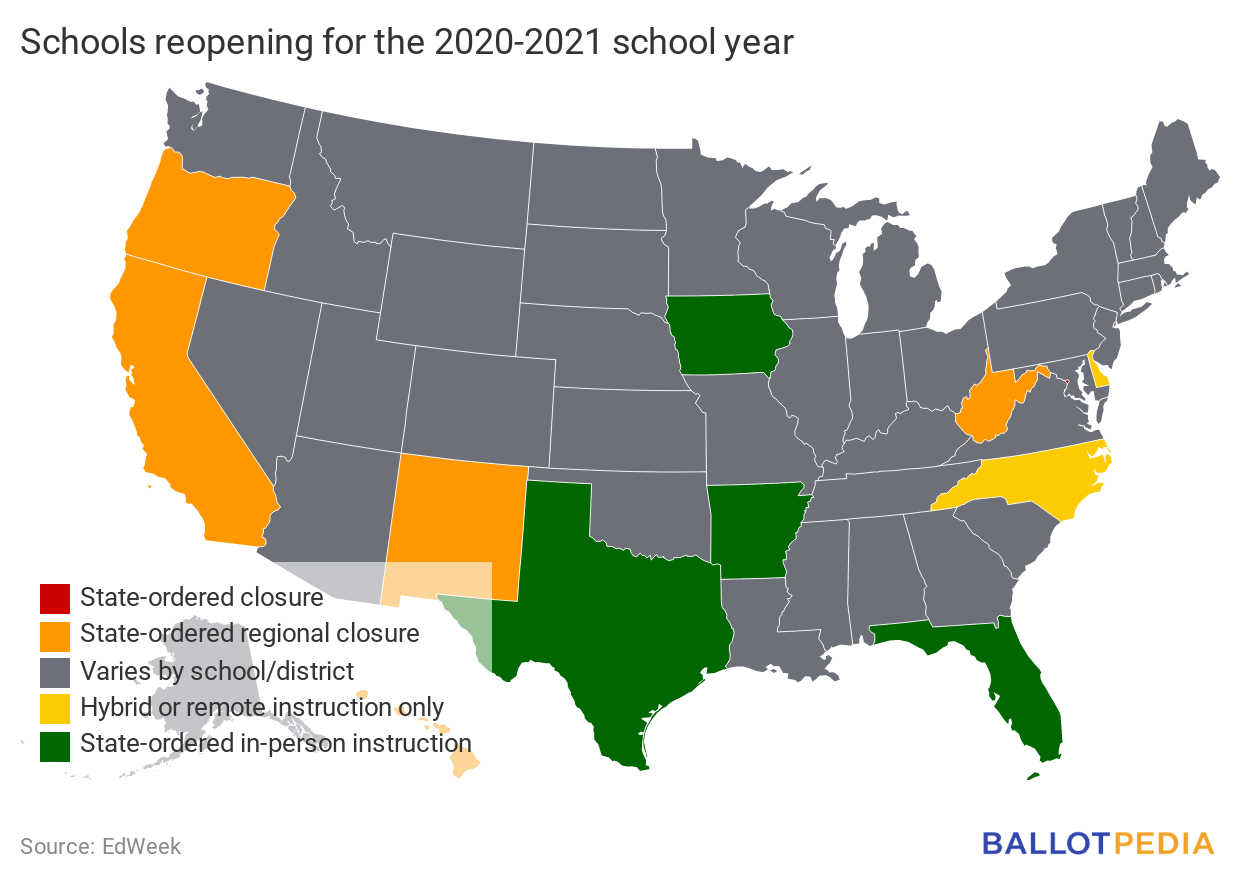Welcome to Documenting America’s Path to Recovery, where we track the status of reopening in all 50 states. Today we look at West Virginia’s addition of a new category in the school reopening system, why Delaware courts have resumed issuing failure to appear warrants, school reopenings, and more. Want to know what happened yesterday? Click here.
Since our last edition
What is open in each state? For a continually updated article on reopening status in all 50 states, click here.
- California (Democratic trifecta): The California Attractions and Parks Association (CAPA) issued a statement asking Gov. Gavin Newsom (D) to release guidelines to allow amusement parks to reopen. CAPA represents parks including Disneyland, Universal Studios, Knott’s Berry Farm, and Legoland.
- Connecticut (Democratic trifecta): Gov. Ned Lamont (D) explained how he wanted schools to handle positive coronavirus cases. “Especially for K through 8, we’re trying to keep that fourth grade class unto itself as a pod as a cohort. So that if there happens to be an infection in that one class, it’s just those 20 students and that teacher who would have to quarantine — not the entire middle school or not the entire school,” he said. Lamont’s remarks came after several schools in the state fully closed after learning of one positive coronavirus case.
- Delaware (Democratic trifecta): Courts in Delaware resumed issuing failure to appear warrants for individuals who do not show up for court dates. The state suspended issuing such warrants in March 2020. Delaware courts will enter Phase Three of reopening in October, increasing staffing levels to 75% capacity.
- Rhode Island (Democratic trifecta): In-person K-12 classes were allowed to resume statewide on Sept. 14. Cumberland and Warwick school districts are starting the school year fully remotely. Most school districts resumed with a hybrid schedule.
- West Virginia (Republican trifecta): On Tuesday, Sept. 15, Gov. Jim Justice (R) announced he was adding a new color—gold—to the color-coding system that determines how schools can reopen. Counties with between 10 and 14.9 COVID-19 cases per 100,000 people will be classified as gold. While in-person learning is allowed in gold counties, there are limits on gatherings and sports travel.
Daily feature: Schools
All 50 states closed schools to in-person instruction at some point during the 2019-2020 academic year. Beginning in May 2020, schools in certain states began to reopen. In which states are schools allowed to open? In which states are they ordered to remain closed?
The current status of school reopenings is as follows:
- Washington, D.C., has a district-ordered school closure
- 2016-17 enrollment: 85,850 students (0.17% of students nationwide)
- Five states (Calif., Hawaii, N.M., Ore., W.V.) have a state-ordered regional school closure
- 2016-17 enrollment: 7,679,753 students (15.18% of students nationwide)
- Two states (Del., Va.) are open for hybrid or remote instruction only
- 2016-17 enrollment: 1,686,326 students (3.33% of students nationwide)
- Four states (Ark., Fla., Iowa, Texas) have state-ordered in-person instruction
- 2016-17 enrollment: 9,180,918 students (18.15% of students nationwide)
- Thirty-nine states have reopenings that vary by school or district
- 2016-17 enrollment: 31,955,012 students (63.17% of students nationwide)

|
Additional activity
In this section, we feature examples of other federal, state, and local government activity, private industry responses, and lawsuits related to the pandemic.
- University of Arizona President Dr. Robert Robbins called for students on or near campus to shelter in place for 14 days. Exceptions to the request include going to in-person classes already being held, getting food, working, or receiving medical treatment.
- Anchorage School District Superintendent Deena Bishop set an Oct. 19 target date for some students to return to in-person instruction. Bishop said the district would begin with elementary and special education students.
- The city council of Portsmouth, New Hampshire, voted 7-2 to enact a mask mandate, effective immediately and lasting through January 2021. Masks must be worn when inside public places or outdoors when social distancing is not possible. Violators can be fined up to $25.
- On Sept. 14, Judge William Stickman IV of the U.S. District Court for the Western District of Pennsylvania struck down some of Pennsylvania Governor Tom Wolf’s (D) COVID-19 orders. The suit was brought on behalf of various Pennsylvania counties, businesses, and elected officials. It challenged Wolf’s restrictions on indoor and outdoor gatherings, the continued closure of “non-life-sustaining” businesses, and prolonged stay-at-home orders. Writing that the “liberties protected by the Constitution are not fair-weather freedoms,” Stickman, an appointee of President Donald Trump (R), ruled that the “Constitution cannot accept the concept of a ‘new normal’ where the basic liberties of the people can be subordinated to open-ended emergency mitigation measures.” In his order, Stickman found
- “(1) that the congregate gathering limits … violate the right of assembly enshrined in the First Amendment;”
- “(2) that the stay-at-home and business closure components of defendants’ orders violate the due process clause of the Fourteenth Amendment;
- “and (3) that the business closure components of defendants’ orders violate the Equal Protection Clause of the Fourteenth Amendment.”
- Stickman limited remedy to the plaintiff individuals and businesses, dismissing the counties for lacking standing to sue. Thomas E. Breth, an attorney for the plaintiffs, said, “You can’t tell 13 million Pennsylvanians that they have to stay home. That’s not America. It never was. That order was horrible.” Lyndsay Kensinger, Wolf’s press secretary, said Wolf would seek to block the decision while seeking an appeal, adding that the “ruling does not impact any of the other mitigation orders currently in place including … mandatory telework, mandatory mask order, worker safety order, and the building safety order.”
|


